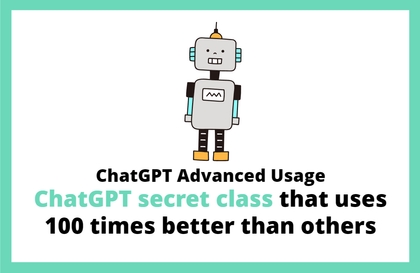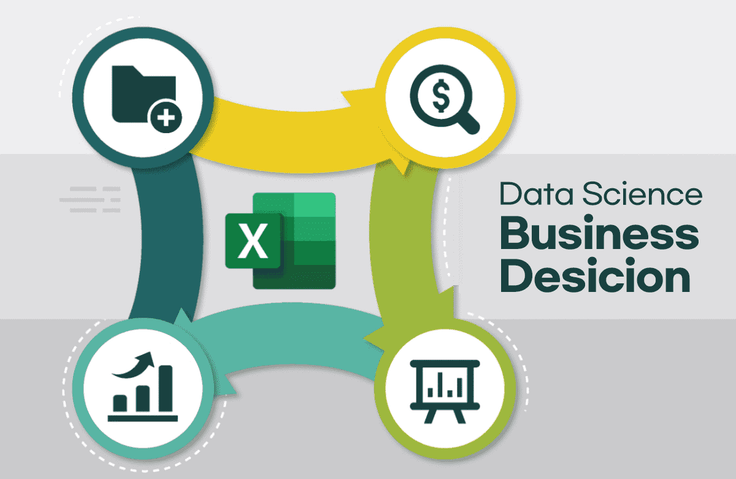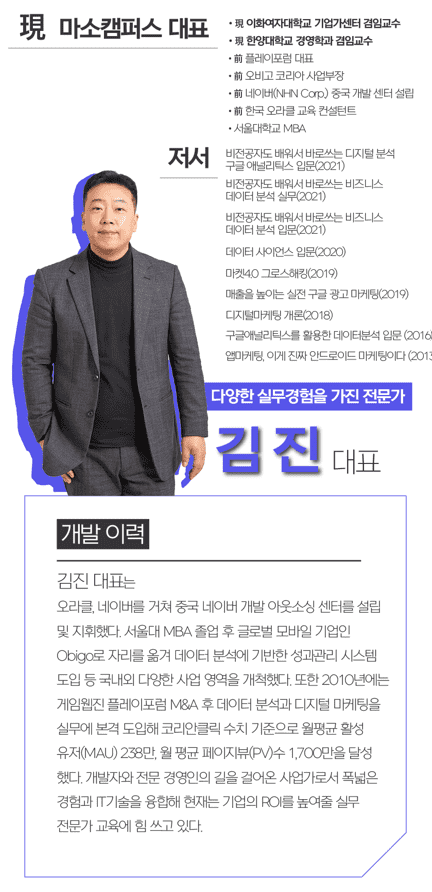
Advanced ChatGPT Usage - ChatGPT Secret Class to Use 100x Better Than Others
Masocampus
AI will not replace people. But 'you utilizing AI' will replace all who don't.
입문
ChatGPT, AI, prompt engineering
This is a Problem-Based Learning course that goes beyond how to use data analysis tools and solves real BQs by following stories based on business problems that are easily encountered in practice.

Understanding the features of data analysis tools and how to use them within your organization
Learn how to use data analytics-based decision making
Gain the ability to run data-driven projects
Analyze and judge real-world data sets from multiple perspectives
Closer to the real problem!
Data Science Masterclass for Business.
🔬 What does it take to do successful data analysis ?
What we really need is “ the ability to create the right data analysis model . ”
But when a data set for data analysis is given ,
Haven't you ever felt lost, as if you were thrown alone into the vast ocean ?
Masterclass on making business decisions with data science
An approach to starting data analysis by practicing with master data close to reality .
We teach you how to build analytical models and develop your problem-solving thinking skills .
“ This class is based on a solid scenario .”
This course is based on the electronics retailer “ Maso Electronics Mart ” .
Thinking about how to solve various problems in reality and finding answers
It is Problem-Based Learning .
Learn by solving real-world business problems using Excel's extended features .
👍 I recommend this to these people
- Those who are at a loss as to where and how to start analyzing data in a practical dataset.
- Those who want to solve various business problems with data by following a solid scenario-based story.
- Learn time series analysis , sensitivity analysis , regression analysis , Pareto analysis, etc. based on actual data sets.
Anyone who wants to have strategic insight into practical decision-making
- Those who want to strengthen their persuasiveness by presenting optimal data according to business goals.
👀 Lecture Features
Key Points from the Master Class on Making Management Decisions with Data Science !
1. Problem-Based Learning that integrates knowledge into realistic situations
Individually viewed for good decision making
Analysis algorithms , functions , Excel analysis functions , visualization techniques , statistics and economics , and management techniques.
We cultivate the ability to melt things into one .
2. Solving everyday business problems through data analysis.
There are several perspectives that organizational members must consider in order to increase sales, which is the goal of corporate activities.
By conducting a practical analysis based on approximately 70,000 daily product sales information data,
After taking the course, you will be able to handle real-world data .
3. Find the easiest solution using a familiar Excel program.
To enable quick decision making in the most effective and efficient way ,
Excel data that can be easily executed by turning it on when you have questions ,
Learn how to draw conclusions as simply as possible .
4. Explore a single data set from multiple perspectives.
There is only one “data of our company ” .
Looking deeper and deeper into a single data set from multiple angles
It requires the ability to uncover hidden insights .
Five years of sales data from a fictitious company called “ Maso Electronics Mart ” from various perspectives
How to deal with the tail-chasing questions through review practice
You will realize that you can reach meaningful conclusions .
🏆 After attending the master class on making business decisions with data science,
After attending the master class on making business decisions with data science,
The capabilities you can have are :
1. For good decision making, analytical algorithms , functions , Excel analysis functions , visualization techniques ,
By melting together the fragmented knowledge of statistics, economics , and management techniques,
Develop the ability to apply knowledge to real-world situations .
2. Even companies that do not have a data system in place may have Excel files.
By conducting practical training with product sales information data
After taking the course, you will be able to handle real-world data .
3. Decisions made through unnecessarily complex analyses are less effective .
Excel data that can be easily executed by turning it on when you have questions .
Learn how to draw conclusions as simply as possible .
4. Minimizing “ observer error ” that occurs during the analysis process
We cover various ways to utilize probability-based decision-making models .
📖 Learning Content












💬 Expected Questions Q&A
Q. What makes simulation lectures different from other lectures ?
A. Throughout the course, students will become executives of Maso Electronics .
So you can immerse yourself in the idea of your own business and learn the decision-making process .
The data handled also reflects reality to fit the identity of the virtual company called ‘ Maso Electronics ’ .
Q. Do I need to be proficient in Excel to follow the class ?
A. Because the instructor goes over each and every button that needs to be clicked.
You don't have to worry about your Excel skills .
Q. I'm not that high in rank yet . Is this lecture only meaningful if you have a high rank ?
A. No, it is not . Only the size of the data being handled may change .
The ability to think data-driven is a required skill regardless of position or field .
Q. Are there any requirements or prerequisites for taking the course ?
A. Since this is a practice-oriented lecture, the lecture screen and practice screen can be separated.
It would be a good idea to prepare dual monitors or extra devices .
Also, since the training is conducted based on Windows OS ,
We recommend taking the course in a Windows environment .

✔️ Please check before taking the class !
- Since this is a hands-on course, we recommend bringing a dual monitor or a spare device to separate the lecture and practice screens . Furthermore, since the practical training will be conducted on a Windows OS , we recommend taking the course on a Windows environment .
- Lecture notes and practice files are available in the <0. Textbook Download Center > section .
Who is this course right for?
For those who are at a loss as to where and how to start analyzing data in a practical dataset
Anyone who wants to solve various business problems with data by following a solid scenario-based story.
Those who want to learn time series analysis, sensitivity analysis, regression analysis, Pareto analysis, etc. based on actual data sets and gain strategic insight into practical decision making
Those who want to strengthen their persuasiveness with optimal data representation according to business goals
Need to know before starting?
As this is a hands-on lecture, we recommend using dual monitors or an extra device to separate the lecture and hands-on screens.
Since the practical training will be conducted based on Windows OS, we recommend taking the course in a Windows environment.
No prior knowledge of data analysis is required.
Ability to handle basic Excel functions is required.
8,805
Learners
1,204
Reviews
108
Answers
4.7
Rating
95
Courses
"어제보다 성장하겠습니다. 그리고, 어제보다 성장하려는 사람을 돕겠습니다."
마소캠퍼스의 진심과 소망을 담은 Actionable Content로,
2013년부터 온오프라인으로 함께해 온 누적 강의 1억시간!
이 소중한 경험과 시간은 언제나 마소캠퍼스와 수강생 모두의 성장의 원천입니다.
마소캠퍼스 팀은 우리의 모두의 성장을 위해 두 가지 원칙을 반드시 지킵니다.
1. 배우면 반드시 쓸 수 있는 Actionable Content
2. 참여자의 시간과 수고를 존중하는 Time-Saving Curriculum
마소캠퍼스의 Actionable and Time-Saving Curriculum으로 성장의 길을 함께 걸어나가길 기원합니다.
All
78 lectures ∙ (12hr 24min)
Course Materials:
All
9 reviews
4.9
9 reviews
Reviews 2
∙
Average Rating 3.0
Reviews 1
∙
Average Rating 4.0
4
The course content is very good. However, while the initial lessons included explanations of calculations and Excel functions, I found it somewhat disappointing that as the course progressed, it increasingly used content from practice Excel files and proceeded without explanations of the Excel functions. Although the course content itself becomes more complex toward the end, if the early parts provided detailed explanations about why certain methods should be used, then the latter parts should have also explained why specific functions need to be used for beginners, or why the Excel formats provided in Monte Carlo are set up that way. While it was easy to follow initially, perhaps due to my limited knowledge of statistics, I can understand and follow the flow, but the question of "why this particular method was used" remains unresolved.
Thank you for leaving a review😊 This course was designed so that anyone can easily follow along by pre-filling the parts that might feel complex as much as possible in advance, so I think there might be the disappointment you mentioned. I will take your valuable feedback into consideration and incorporate more detailed content into future course production!
Reviews 1
∙
Average Rating 5.0
5
It was good.
Thank you! I am glad that you said it was a good lecture. I will continue to strive to provide good lectures in the future.
Reviews 1
∙
Average Rating 5.0
Reviews 7
∙
Average Rating 5.0
Limited time deal ends in 7 days
$86.90
29%
$123.20
Check out other courses by the instructor!
Explore other courses in the same field!